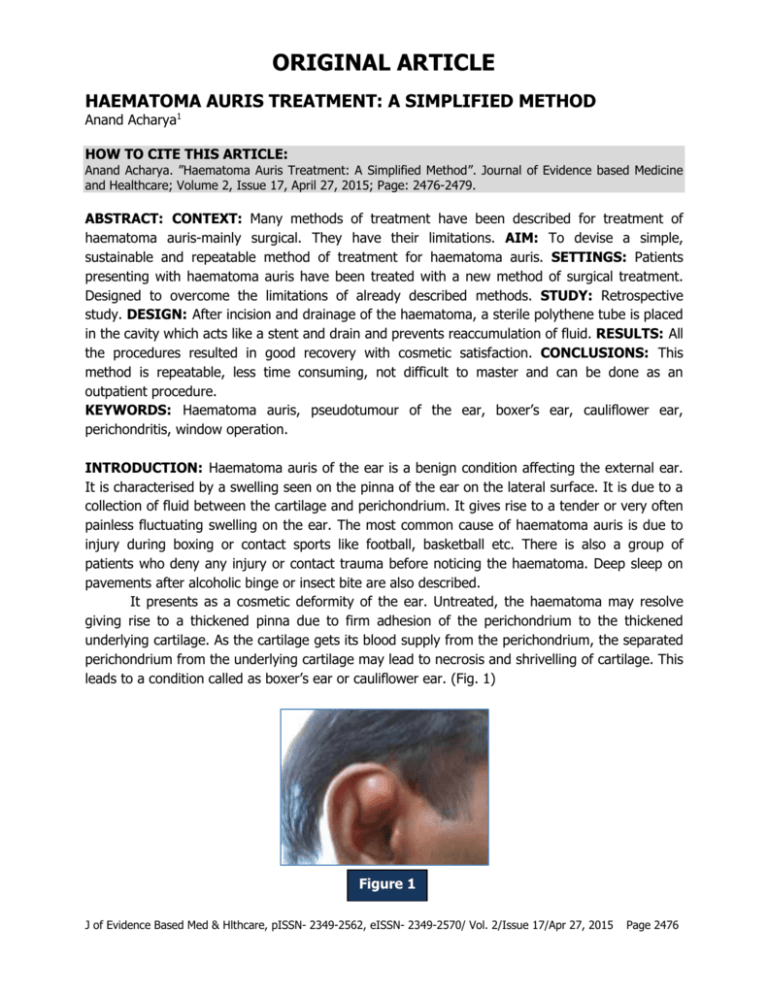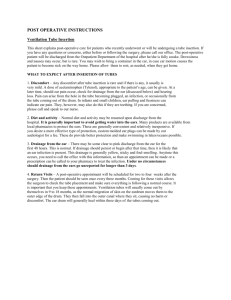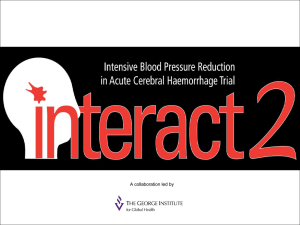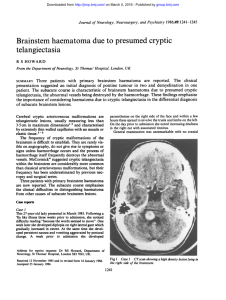01 - Anand Acharya - Journal of Evidence Based Medicine and
advertisement

ORIGINAL ARTICLE HAEMATOMA AURIS TREATMENT: A SIMPLIFIED METHOD Anand Acharya1 HOW TO CITE THIS ARTICLE: Anand Acharya. ”Haematoma Auris Treatment: A Simplified Method”. Journal of Evidence based Medicine and Healthcare; Volume 2, Issue 17, April 27, 2015; Page: 2476-2479. ABSTRACT: CONTEXT: Many methods of treatment have been described for treatment of haematoma auris-mainly surgical. They have their limitations. AIM: To devise a simple, sustainable and repeatable method of treatment for haematoma auris. SETTINGS: Patients presenting with haematoma auris have been treated with a new method of surgical treatment. Designed to overcome the limitations of already described methods. STUDY: Retrospective study. DESIGN: After incision and drainage of the haematoma, a sterile polythene tube is placed in the cavity which acts like a stent and drain and prevents reaccumulation of fluid. RESULTS: All the procedures resulted in good recovery with cosmetic satisfaction. CONCLUSIONS: This method is repeatable, less time consuming, not difficult to master and can be done as an outpatient procedure. KEYWORDS: Haematoma auris, pseudotumour of the ear, boxer’s ear, cauliflower ear, perichondritis, window operation. INTRODUCTION: Haematoma auris of the ear is a benign condition affecting the external ear. It is characterised by a swelling seen on the pinna of the ear on the lateral surface. It is due to a collection of fluid between the cartilage and perichondrium. It gives rise to a tender or very often painless fluctuating swelling on the ear. The most common cause of haematoma auris is due to injury during boxing or contact sports like football, basketball etc. There is also a group of patients who deny any injury or contact trauma before noticing the haematoma. Deep sleep on pavements after alcoholic binge or insect bite are also described. It presents as a cosmetic deformity of the ear. Untreated, the haematoma may resolve giving rise to a thickened pinna due to firm adhesion of the perichondrium to the thickened underlying cartilage. As the cartilage gets its blood supply from the perichondrium, the separated perichondrium from the underlying cartilage may lead to necrosis and shrivelling of cartilage. This leads to a condition called as boxer’s ear or cauliflower ear. (Fig. 1) Figure 1 J of Evidence Based Med & Hlthcare, pISSN- 2349-2562, eISSN- 2349-2570/ Vol. 2/Issue 17/Apr 27, 2015 Page 2476 ORIGINAL ARTICLE Haematoma auris is seen more often in males because of their outdoor occupations, exposure to assaults, more involvement in contact sports, and other activities. Females also have an infrequent incidence wherein the precedence of trauma is not forthcoming. It is more often a unilateral disease except in boxer’s who may have a bilateral presentation because of their involvement in the sport. To prevent shrinking of the cartilage resulting in cosmetic deformity, treatment is necessary also to prevent the development of perichondritis of the ear. Treatment of the haematoma auris by simple aspiration leads to reaccumulation of fluid. Aspiration and pressure drainage over the ear have also followed by recurrence. Incision and drainage with introduction of antibiotic impregnated guaze called as, window operation, with daily dressing is also described. Other methods of treatment advised are incision and drainage followed by pressure bandage with cotton balls in the concavities of the concha. Methods of incision and drainage with mattress sutures opposing the skin surfaces are also described. Incision and drainage with dental rolls over which through and through sutures from lateral to medial surfaces of concha are also described. Placing silastic plates on the lateral and medial surfaces as splints to prevent reaccumulation have been described.All these procedures need prolonged postoperative care, repeated dressings and hospitalisation. Despite all these methods described, satisfactory resolution with good cosmetic appearance are not seen in all the methods. The search for a easy, repeatable and sustainable method with good cosmetic posttreatment appearance, led to designing a new method of approach. MATERIALS AND METHODS: Over a period of 15 years, from 1999 to 2014 a total of 53 cases seen by the author, comprising of 41 males and 12 females of age group of 21 to 45 years, a different approach to treatment of haematoma auris was devised. The treatment devised was, under aseptic conditions and local anesthesia, with 1% Lignocaine, the skin over the most dependent part of the haematoma was infiltrated and was incised after 5 minutes along the margins in the cavity of the concha and the fluid was drained. A polythene tubing of scalp vein set was procured. Small cuts on the side of the polythene tube were placed to drain the fluid. This perforated tube was used as a drain into the cavity of the haematoma. The tube was sutured to the skin on the lateral aspect of the incision made on the auricle. The placement of the tube acted like a stent and also as a drain and hence there was no collection and the skin collapsed against the cartilage to obliterate the cavity. Manual pressure over the dressing by the patient himself lead to the drainage of fluid, if any, and closure of the cavity. (Fig. 2). Figure 2 J of Evidence Based Med & Hlthcare, pISSN- 2349-2562, eISSN- 2349-2570/ Vol. 2/Issue 17/Apr 27, 2015 Page 2477 ORIGINAL ARTICLE After 7 days, when the contours of the auricle were seen properly and confirming no more collection of fluid, the drain was removed to let the wound heal normally, (Fig. 3). Figure 3 RESULTS: In 53 cases, consisting of 41 males and 12 females, this method was satisfactory in achieving good results. Two male patient were found to have a residual collection in the scaphoid fossa of the ear, for which a reintroduction of the stent tube was done and subsequently did not have a recurrence. There was no incidence of perichondritis in any case. Final achievement of the cosmetic appearance has led to a proper and early resolution. DISCUSSION: Many methods of drainage of haematoma auris have been described in the literature. The commonly done window operation entails packing the cavity with ribbon guaze impregnated with antibiotics. Repeated insertion of guaze leads to shrivelling and delayed resolution. Methods of closure after drainage with mattress sutures to prevent recollection are reported.(1) Other methods like drainage and suturing over silicon buttons to prevent recollection are also described.(2,3,4 and 5) It was noted that there was a recurrence in many instances and sometimes the skin overlying the ear became thickened and disfigured or in some cases perichondritis ensued. This simple and effective procedure was designed to overcome some of these problems. The polythene tubing of the scalp vein set is used as a stent to prevent collapse of the cavity and also act as a drainage tube. This combined function prevents recollection of fluid enabling the perichondrium to adhere to the cartilage and prevent recurrence. Post-operative wound bandage with pressure and manual pressure over the dressing by the patient also aids in early recovery. It is also cost effective. This report is communicated in view of its easy, predictable safe, effective and easy to learn method. REFERENCES: 1. Giles WC, Iverson KC, King JD, Hill FC, Woody EA, Bouknight AL. Incision and drainage followed by mattress suture repair of auricular haematoma. Laryngoscope. Dec 2007; 117(12); 2097-9. J of Evidence Based Med & Hlthcare, pISSN- 2349-2562, eISSN- 2349-2570/ Vol. 2/Issue 17/Apr 27, 2015 Page 2478 ORIGINAL ARTICLE 2. Lane SE, Rhame GC, Wroble RL. A silicon splint for auricular haematoma. The Physician and Sports Medicine. 1998; 26(9); 77-80. 3. Santosh Vivekanadan, Anukiran R, Arcot Rekha. Haematoma auris. SRJM 2013; 6; 30-31. 4. Ramadass T, Gopi Ayyaswamy. Pseudocyst of the auricle-Etiopathogenesis, Treatment update and literature review. Indian Journal of Otolaryngology & Head & Neck Surgery Vol. 58, No. 2, April-June 2006. 5. Nahl SS, Kent SE, Curry AR. Treatment of auricular haematoma by silicone rubber splints. J. Laryngol. Otol. Dec 1989; 103 (12); 1146-9. AUTHORS: 1. Anand Acharya PARTICULARS OF CONTRIBUTORS: 1. Associate Professor, Department of ENT, Government Medical College, Nizambad, Telengana. NAME ADDRESS EMAIL ID OF THE CORRESPONDING AUTHOR: Dr. Anand Acharya, 3-9-47/1, Ramanthapur, Hyderabad – 500013. E-mail: acharya.is.anand@gmail.com Date Date Date Date of of of of Submission: 12/04/2015. Peer Review: 13/04/2015. Acceptance: 14/04/2015. Publishing: 22/04/2015. J of Evidence Based Med & Hlthcare, pISSN- 2349-2562, eISSN- 2349-2570/ Vol. 2/Issue 17/Apr 27, 2015 Page 2479



